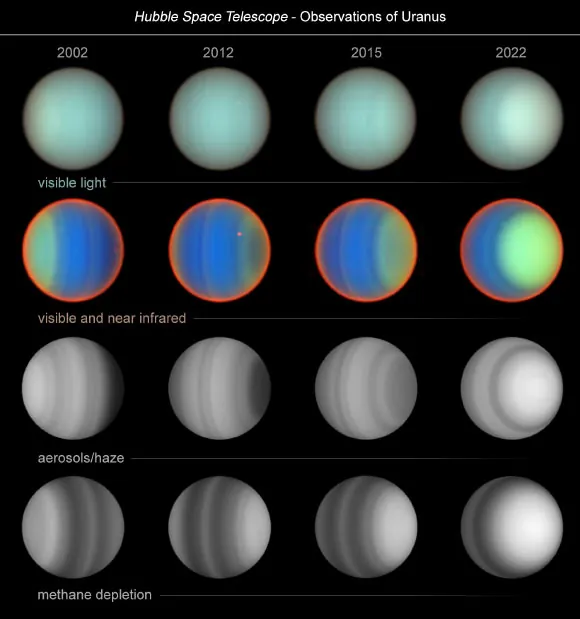
Hubble Unveils the Hidden Secrets of Uranus' Atmosphere: A 20-Year Journey
2025-04-01
Author: Wei Ling
Introduction
A groundbreaking 20-year study conducted using the Hubble Space Telescope has significantly enriched our understanding of Uranus, the enigmatic ice giant of our solar system. With a diameter nearly four times that of Earth, Uranus presents a unique opportunity for scientists, providing insights that may help us study exoplanets of comparable size and composition.
Atmospheric Composition
Uranus boasts a distinctive atmosphere primarily composed of hydrogen and helium, with traces of methane granting it a striking blue hue. Unlike gas giants like Jupiter and Saturn, Uranus exhibits peculiar atmospheric dynamics— notably its tilted rotation and a lopsided magnetic field that is tilted 60 degrees from its axis.
Historical Observations
The 1986 Voyager 2 flyby offered the first close-up glimpse of this unconventional planet, revealing its bluish, bland features akin to a giant billiard ball. In contrast, Hubble's observations from 2002 to 2022 painted a vivid two-decade narrative of seasonal changes, led by a team of astronomers including Dr. Erich Karkoschka from the University of Arizona, and Drs. Larry Sromovsky and Pat Fry from the University of Wisconsin.
Key Findings
The team observed Uranus during four key years: 2002, 2012, 2015, and 2022. Their findings indicate that, unlike the more even distribution of methane seen in other gas giants, Uranus exhibits a significant depletion of methane at its poles—a phenomenon that remained consistent over the study's duration.
Seasonal Changes
Interestingly, as the planet heads towards its northern summer solstice in 2030, dramatic changes have been observed in the aerosol and haze structures, which have brightened notably in the northern polar region. Due to Uranus' lengthy orbital period of approximately 84 Earth years, the Hubble observations primarily captured the progression towards northern spring as sunlight shifts from the equator to the north pole.
Research Implications
"Hubble observations suggest complex atmospheric circulation patterns on Uranus during this period," the researchers stated. Their data, particularly sensitive to methane distribution, indicates a pattern where downwelling occurs in the polar regions, contrasted with upwelling in other areas.
Conclusion
As we continue to unveil the mysteries of our solar system through astrological studies and advancements in telescope technology, this significant research not only enhances our understanding of Uranus but could also provide critical insights into the atmospheric dynamics of distant exoplanets lurking in the shadows of their own distant stars. This study is a vital step toward understanding the vast cosmos that surrounds us. Keep your eyes on the skies, as the secrets of planets—both familiar and alien—are yet to be uncovered!
 Brasil (PT)
Brasil (PT)
 Canada (EN)
Canada (EN)
 Chile (ES)
Chile (ES)
 Česko (CS)
Česko (CS)
 대한민국 (KO)
대한민국 (KO)
 España (ES)
España (ES)
 France (FR)
France (FR)
 Hong Kong (EN)
Hong Kong (EN)
 Italia (IT)
Italia (IT)
 日本 (JA)
日本 (JA)
 Magyarország (HU)
Magyarország (HU)
 Norge (NO)
Norge (NO)
 Polska (PL)
Polska (PL)
 Schweiz (DE)
Schweiz (DE)
 Singapore (EN)
Singapore (EN)
 Sverige (SV)
Sverige (SV)
 Suomi (FI)
Suomi (FI)
 Türkiye (TR)
Türkiye (TR)
 الإمارات العربية المتحدة (AR)
الإمارات العربية المتحدة (AR)